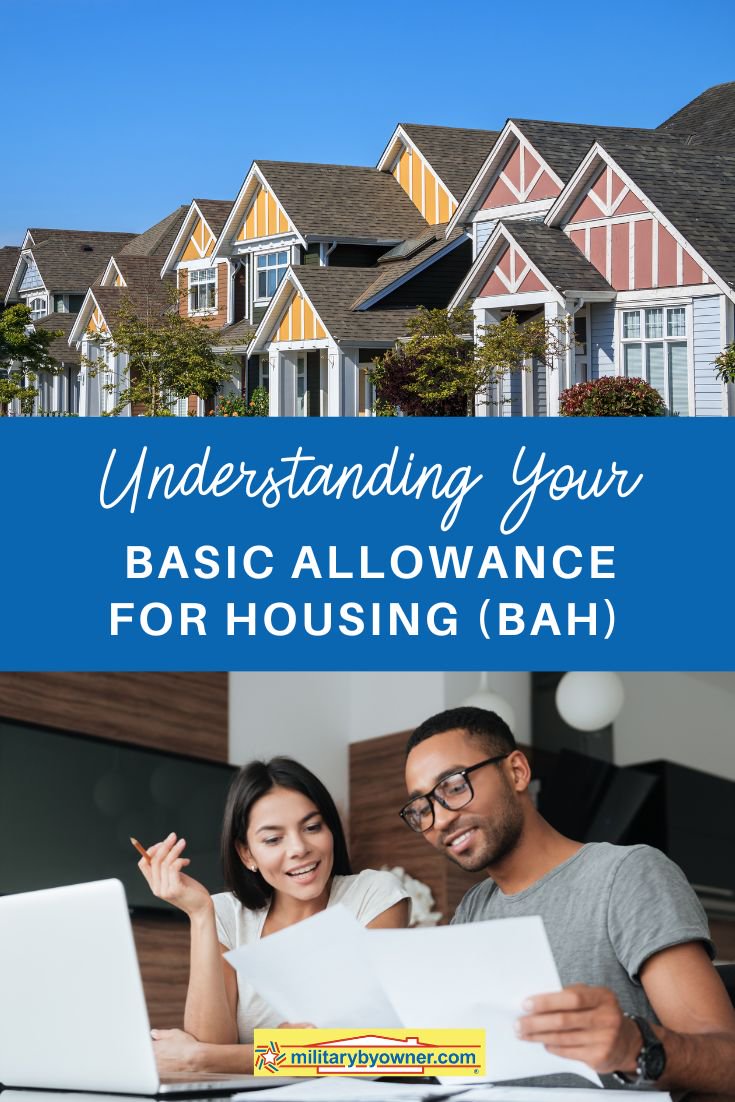Understanding Your Basic Allowance for Housing
In this article:

Image from Canva
How much thought have you given to your Basic Housing Allowance (BAH)?
As military families, we know that it exists and that it’s intended to cover our cost of living. But it’s more than just a number and well-known military acronym; it affects both on our budgets and our standard of living.
Understanding what it is, how it works, and how to use it to our advantage works great lengths to help us not only respect it but thrive with the amount the government has allotted us.
What Is BAH?
"Basic Allowance for Housing, or BAH, provides uniformed service members equitable housing compensation based on housing costs in local civilian housing markets within the Continental United States (CONUS) when government quarters are not provided." -Defense Travel Management Office
There’s a lot of thought, research, and intention behind each location's BAH.
Here are the details behind the numbers:
Every year, the government collects housing cost data for about 300 military housing areas across the U.S. (including Alaska and Hawaii). With help from the local military housing offices and input from nearby commands, they determine the cost for adequate housing units in that area or a particular neighborhood.
Factors also include the median current market rent and the average cost of utilities (electricity, heat, water/sewer).
The calculations to determine BAH rates are so deliberate that six housing profiles are created to account for the different home types and number of bedrooms for each area. Then, the BAH is calculated for each pay grade for those with and without dependents.
While understanding the ins and outs of BAH doesn’t change your allowance, it might help grow your understanding of the topic.

Image from Canva
What BAH Is Intended to Cover
“Your BAH isn’t intended to cover 100% of your housing expenses—95% is more accurate. That leaves the remaining 5% coming from the remainder of your paycheck. Is 5% a lot? As far as percentages are concerned, no. But depending on where you live, you might find that 5% equates to several hundred dollars—a crucial thing to keep in mind as you start drafting your budget to stay within your new BAH rate.” — Tips for Living Within Your BAH
What BAH Is Not
Remember, BAH is based on the cost of housing in an area. It’s not calculated by a member's expenses. This means that you’ll find that some thrive within the allotted BAH, while others think it falls short of their financial needs. Ultimately, it comes down to budgeting.
When BAH Doesn't Apply
When you move overseas (not Hawaii or Alaska), you’ll find that BAH no longer applies. Instead, the Overseas Housing Allowance (OHA) replaces it.
"The Overseas Housing Program enables authorized Service members assigned to permanent duty overseas to lease privately-owned housing. The Overseas Housing Allowance (OHA) is a cost-reimbursement allowance and is designed to offset housing costs. It includes three separate components: rent, utilities/recurring maintenance, and a move-in housing allowance (MIHA)." — Defense Travel Management Office
Other allowances to factor:
Now, there’s another type of allowance that the government permits without replacing your BAH, the COLA.
The Cost of Living Allowance (COLA) is another government allotment provided to military members in specified areas, both CONUS (Continental U.S.) and OCONUS (overseas).
- CONUS COLA is designed to help offset higher prices in the highest cost-of-living locations that exceed the average cost in the continental U.S. by 8 percent or more.
- “Service members serving outside of the continental United States (OCONUS) where the cost of living is higher than CONUS receive an Overseas Cost-of-Living Allowance (COLA). Overseas COLA is a non-taxable allowance designed to offset higher prices of non-housing goods and services OCONUS and equalize purchasing power with members stationed in CONUS. It does not reimburse expenses, compensate for remoteness, hardship, loss of spousal income, or non-availability of goods and services.” — Defense Travel Management Office
When applicable, COLA offers a cushion to help ease your budget and maintain your standard of living in higher cost of living locations. While it’s usually not enough to rework your numbers, you shouldn’t overlook it before analyzing your finances and starting your house hunt.
Find out how much you qualify for with these COLA calculators:

Image from Canva
Navigating BAH Fluctuations
While our finances need constant tending, military families completely rework their budgets every PCS move, due to BAH changes. That portion of the budget holds a lot of weight among active-duty military members.
Our cost of living, whether we’re talking about housing, groceries, utilities, gas, or all of the above, fluctuates from duty station to duty station. While some moves won’t see much change in BAH, other military moves, such as a PCS from Offutt AFB in Nebraska to Joint Base Pearl Harbor-Hickam in Hawaii, will rattle your numbers.
Yes, the BAH fluctuates to reflect the change in the cost of living, but that’s only part of the picture. Let’s say that you bought a home in SoCal when you received orders to MCAS Miramar. Then, you got orders to MCAS Cherry Point. Your cost of living, along with your BAH, will drop. But your property in Southern California? The expenses stay the same. The solution? Sell or find a renter to move in and pay the mortgage.
Sounds easy enough, and for many, it works perfectly. But what if you can’t sell as intended or you can’t find a tenant to fill the property? You’re keeping your California expenses and adding your North Carolina cost of living to it.
There’s no cut-and-dried answer to this particular situation. What’s best for some won’t be for others, but it does need consideration when looking at your budget and where you'll live, specifically whether or not to buy or rent, at each duty station. The local cost of living and maintainability, should you PCS to a less expensive area (like the example above), can help you determine the answer.
back to top
Tips for Living Within Your BAH
The bottom line? Your Basic Housing Allowance isn’t your budget. You create your budget. So, how far do you want your BAH to stretch? Do you want your BAH to only cover rent/mortgage or include all cost of living expenses like utilities, gas, and maybe even groceries?

Image from Canva
5 Questions to Ask When Setting Your Househunting Budget
- How much is your BAH? While it’s not the be-all, end-all of your budget, your BAH sets a pretty good foundation to build from. Get information about current BAH rates here.
- How much are utilities? Experts say to expect to pay about $400 a month, but this number boils down to where you live. Of course, you might be able to cut down on that expense.
- Where do you want to live in proximity to the base? Proximity to the base is everything, especially when you're stationed in a major city like Washington, D.C. or San Diego. In those areas, the cost of being close to base is typically much higher than living somewhere out of the main metropolitan area.
- What are your must-haves? Start with the big things like the type of property (condo, apartment, single-family home) that you want or need. Then move down to the number of bedrooms and bathrooms you need to be comfortable. Lastly, look at the details.
- What are your wish-list items? Everything has a price. If a fenced-in yard, pool, fitness center, proximity to great schools, and a two-car garage are critical to you, that helps narrow your budget and your search. While some perks may fit within your budget, others will have to go—this is typically the step where your financial planning is tested!
But don’t forget about your financial goals. Your ambitions, whether it’s to invest more money for retirement, save for your kid’s college tuition, pay off debt, or something else, can influence your househunting budget, as does the current housing market.
While you might be accustomed to living under your BAH to work for your financial freedom or future, some duty stations make it harder. What you can get for less than BAH in Missouri might be just fine to call home or even be favorable, but in larger metropolitan areas, it takes every penny of that allowance to find a suitable home for you and your family.
Is it okay to spend beyond my BAH?
Yes! Assuming that you’re not going to put yourself deeper into debt, it’s absolutely okay to live beyond your BAH. Most families have done it at one point or another but again, it’s subjective. It all comes down to your needs and wants.
Duty stations like Schofield Barracks in Hawaii might require that you live at the top end of your budget or beyond to cross off all the priorities you've determined. While that’s not to say that you can’t find a property within BAH, sometimes it’s a matter of compromising. Only you can decide which is the better option.
Your BAH is a number that packs a punch. It’s often the foundation for your budget, house hunting, and influences your investments, so the topic requires some thought. Hopefully, you walk away with a better understanding and a healthy respect for your local BAH and its role in your finances.
By Danielle Keech


back to top